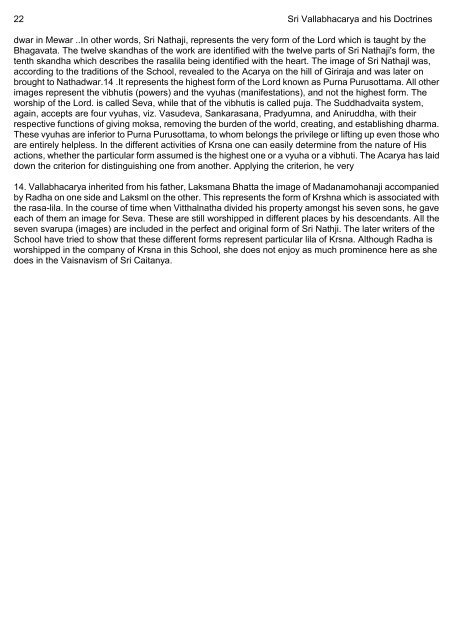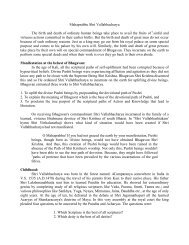Sri Vallabhacharya - Pushti Darshan
Sri Vallabhacharya - Pushti Darshan
Sri Vallabhacharya - Pushti Darshan
You also want an ePaper? Increase the reach of your titles
YUMPU automatically turns print PDFs into web optimized ePapers that Google loves.
22 <strong>Sri</strong> Vallabhacarya and his Doctrines<br />
dwar in Mewar ..In other words, <strong>Sri</strong> Nathaji, represents the very form of the Lord which is taught by the<br />
Bhagavata. The twelve skandhas of the work are identified with the twelve parts of <strong>Sri</strong> Nathaji's form, the<br />
tenth skandha which describes the rasalila being identified with the heart. The image of <strong>Sri</strong> Nathajl was,<br />
according to the traditions of the School, revealed to the Acarya on the hill of Giriraja and was later on<br />
brought to Nathadwar.14 .It represents the highest form of the Lord known as Purna Purusottama. All other<br />
images represent the vibhutis (powers) and the vyuhas (manifestations), and not the highest form. The<br />
worship of the Lord. is called Seva, while that of the vibhutis is called puja. The Suddhadvaita system,<br />
again, accepts are four vyuhas, viz. Vasudeva, Sankarasana, Pradyumna, and Aniruddha, with their<br />
respective functions of giving moksa, removing the burden of the world, creating, and establishing dharma.<br />
These vyuhas are inferior to Purna Purusottama, to whom belongs the privilege or lifting up even those who<br />
are entirely helpless. In the different activities of Krsna one can easily determine from the nature of His<br />
actions, whether the particular form assumed is the highest one or a vyuha or a vibhuti. The Acarya has laid<br />
down the criterion for distinguishing one from another. Applying the criterion, he very<br />
14. Vallabhacarya inherited from his father, Laksmana Bhatta the image of Madanamohanaji accompanied<br />
by Radha on one side and Laksml on the other. This represents the form of Krshna which is associated with<br />
the rasa-lila. In the course of time when Vitthalnatha divided his property amongst his seven sons, he gave<br />
each of them an image for Seva. These are still worshipped in different places by his descendants. All the<br />
seven svarupa (images) are included in the perfect and original form of <strong>Sri</strong> Nathji. The later writers of the<br />
School have tried to show that these different forms represent particular lila of Krsna. Although Radha is<br />
worshipped in the company of Krsna in this School, she does not enjoy as much prominence here as she<br />
does in the Vaisnavism of <strong>Sri</strong> Caitanya.



